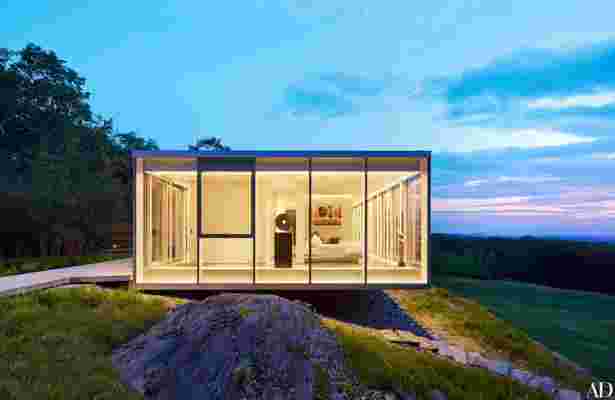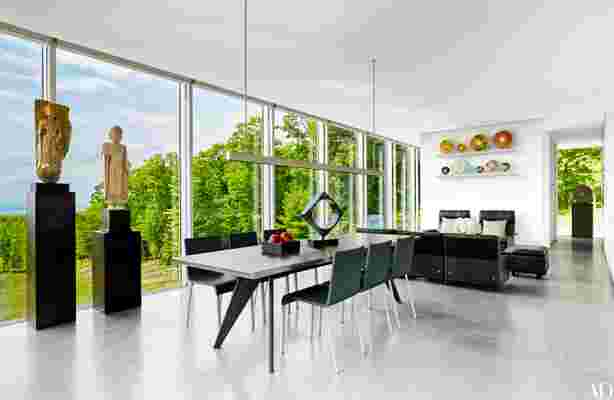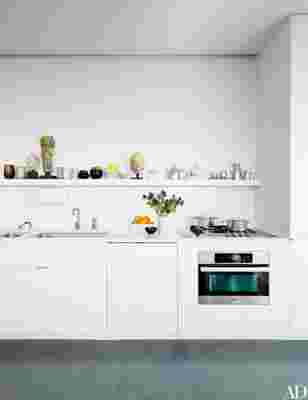People who live in glass houses need to do their homework. Take it from Bob Greenberg, a media executive, and his wife, Corvova Lee, an artist. After purchasing a 240-acre plot in New York’s Hudson Valley nine years ago, the Manhattan-based couple enlisted architect Toshiko Mori to not only design a weekend retreat but also act as their teacher. With Mori, a longtime Harvard professor, the pair studied some of the country’s best-known glass dwellings, among them Mies van der Rohe’s 1951 Farnsworth House , outside Chicago, and Philip Johnson’s 1949 Glass House in New Canaan, Connecticut. If these midcentury marvels offered an education in style, they also presented a few sobering lessons. “Too cold, too hot, fogged-up glass, no ventilation,” Greenberg says, rattling off some of the buildings’ disadvantages. “These homes were not very livable except in perfect weather.”
And so with Mori’s help, the couple set out to reinvent the glass house. That meant tackling practical problems as well as providing more space than either the Mies or Johnson icons. But how to do all that while retaining the sleek aesthetic? Their solution was to create four small structures connected by concrete walkways—a kind of modernist Adirondack camp. With an open plan that contains a combined living/dining/kitchen area plus the master bedroom, the main house is all Greenberg and Lee need when they’re up for the weekend alone. (At 1,240 square feet, it’s roughly the same size as the Farnsworth House.) There’s also a cooking pavilion, where they can entertain large groups, and an exercise pavilion for yoga and Gyrotonics. Situated slightly apart from that clutch of buildings is the guesthouse, complete with two suites and a modest living room and kitchenette.
Instead of cooling and heating a vast house that’s mostly unoccupied, the couple can use any of the four volumes (which total 4,000 square feet) as needed. “It’s an anti-McMansion statement,” says Greenberg, who realized just how little space he and his wife actually required when, during construction, they would occasionally sleep in an Airstream trailer on the grounds. Remembers Mori, “Bob and Corvova asked me to reduce the size of each building so the experiences could be more intimate. It’s about living in each moment and appreciating the specific space one occupies.”



To develop superslim structural frameworks for the pavilions, Mori turned to Bill Baker, the engineer responsible for Dubai’s Burj Khalifa, the tallest building in the world. While the architect didn’t want Baker to hide any supports—“it’s important for people to see what’s doing what,” Mori says—she did want them to recede. Baker came up with a network of columns that, at two inches wide by two inches deep, are even smaller than the home’s window mullions. “It’s very radical, with an amazingly delicate appearance,” Mori says of the residence, which Baker refers to as a “one-story skyscraper” on account of all the innovation that went into it. “At this very human scale,” he notes, “every detail matters.”
The materials palette was likewise tightly controlled, with splashes of white paint, polished-concrete floors, and aluminum accents, which Mori gave a MacBook-style gleam. Wood, though nearly absent inside, is nonetheless ever-present on the grounds, where the homeowners added conifers, dogwood, and winterberries with the help of landscape designers Edwina von Gal and Richard Herbert. (Each building is like a terrarium in reverse.) While Greenberg and Lee love to experience nature on weekends, they both confess they would prefer to do so without having to change out of their city clothes. Those tend to be Comme des Garçons. Thirty years ago, the couple met when he was shopping in one of the brand’s stores and she was employed as a stylist for the Japanese label’s founder, Rei Kawakubo.
When it came to furniture, the pair worked with Mori to choose the home’s small number of pieces. Black leather seating by Dieter Rams mingles with a Mies cocktail table, while molded-plastic chairs by Maarten van Severen join a Jean Prouvé stainless-steel dining table. Confronting that sleekness is the couple’s trove of Chinese sculpture, much of it produced during the Northern Qi dynasty, from 550 to 577 A.D. “That was a very rich period culturally,” explains Hudson, New York–based antiquities dealer Tom Swope, who sold Greenberg and Lee many of the works, which provide touches of historic patina.
For Greenberg, however, the compound is all about the future. His firm, R/GA, an advertising agency that has expanded into digital marketing, helps companies use Internet technology to maximum effect. The goal was for the residence to be what he calls a “connected home,” with lighting, security, heating/cooling, and other systems that could all be controlled from anywhere on the property—or, for that matter, anywhere in the world.
Fine-tuning those systems took three years, recalls Lee, admitting that what was for her husband a pursuit of passion sometimes felt like a never-ending process. But not long ago Greenberg let a delivery truck through the front gate by touching his iPhone. “I was in Portugal, on a boat,” he says triumphantly, adding, “The house works.”
